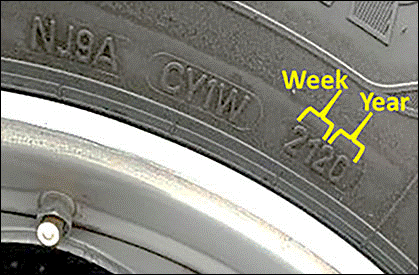Goods Vehicles, Buses, Coaches and Minibuses
Content produced by the DVSA, shouts loudly about what many operators have known for a very long time – old tyres are dangerous and should not be fitted to commercial vehicles under any circumstances.
Tyre Content
- Identifying the date of tyre manufacture
- Using older tyres on other axles
- Tyre Roadworthiness inspections
- Penalties fines for use of old tyres
It is illegal for the front (steering) axle or axles of:
- Goods vehicles with a gross mass of more than 3.5 tonnes
- Buses
- Coaches
- Minibuses and also to the rear axle, or axles, unless equipped with twin wheels to use tyres aged more than 10-years
To prove the age of a tyre it is further required that the manufacture date, printed on the tyre, remain legible on all tyres.
Re-treaded tyres are subject to the same requirement as first-life tyres. The date of re-treading, instead of the date of the first manufacture, will be used to determine the tyre age.
The only exemptions are vehicles;
- Currently excluded from tyre roadworthiness regulations (as stated in regulation 27 (4) (a) of the Road Vehicles (Construction and Use) Regulations 1986 defined as being of historical interest, providing they are not used for commercial purpose
The Road Vehicles (Construction and Use) (Amendment) Regulations 2020, introduced new requirements that ban the use of tyres aged more than 10-years on certain vehicles.
Identifying the date of tyre manufacture
Tyres sold in GB are required to have their date of manufacture marked on the sidewall. This date is shown as a 4-digit number; the first two digits indicate the week number in which the tyre was manufactured and the last two digits the year. In the example given the tyre was manufactured in week 21 of 2020.

The date of tyre manufacture marking must always be legible. Using a tyre where the marking is damaged or defaced would be an offence.
Using older tyres on other axles
It is lawful, but not recommended; to use tyres aged more than 10-years on other axles.
Research has found that tyre structural deterioration can occur in older tyres, which cannot be identified through visual inspection. Owners are recommended to;
- Record
- Monitor
The age of tyres on vehicles is now monitored by authorities, MOT centres and workshops alongside other maintenance controls which should be inplace.
See below a DVSA Guide to maintaining roadworthiness - You will find information on the 'Tyre management system' on page 62 that you should be following. It is the vehicle owner’s or operator’s responsibility to make sure their tyres do not present a road safety risk.
Tyre roadworthiness inspections
The presence of a tyre aged more than ten years in a position as defined is classed as a dangerous defect. This will lead to the refusal of a roadworthiness certificate at the annual inspection. If this defect is identified elsewhere, for example at the roadside, it will attract a prohibition.
Penalties
It will be an offence to:
- Use
- Cause
- Permit to be used
Penalties for misuse are:
- Fixed penalty notices
- Fines
- Driving licence penalty points
- Disqualification from driving
The maximum fine is Level 5, a potentially unlimited amount in England and Wales, but capped at £5,000 in Scotland.
Source: DVSA, Published: 15 January 2021